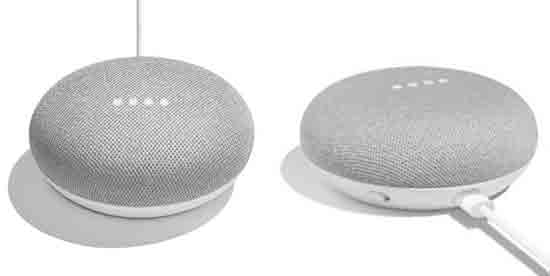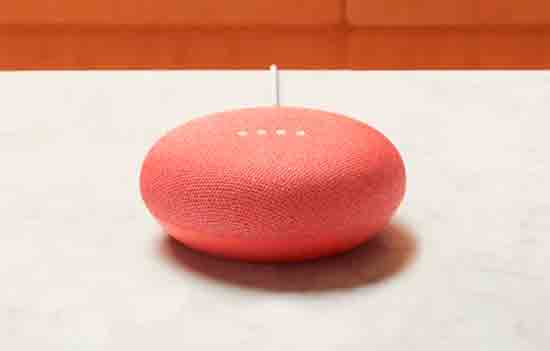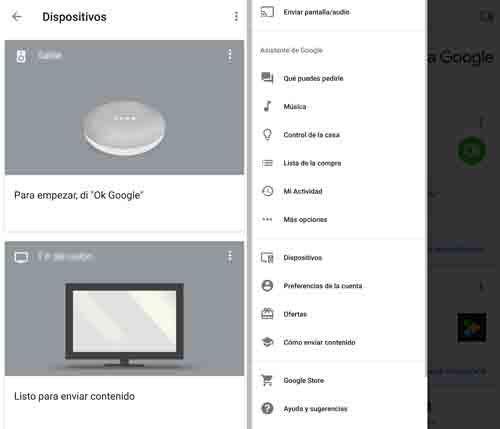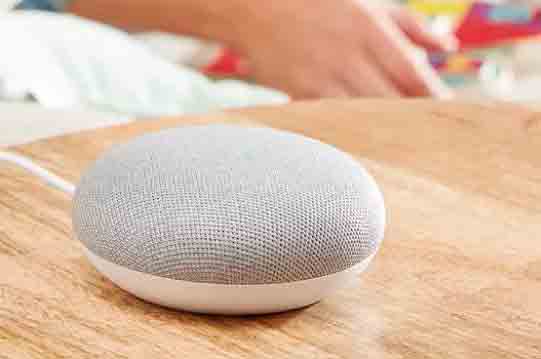In an era where voice assistants and smart speakers are proliferating, two competitors are fighting to lead the race. The Alexa range from Amazon, and the Google Home range from Google.
Google Home Mini is the little one in Google’s family of smart speakers. A range that completes the Google Home and Google Home Max (the latter not available in Spain). A strong bet by Google to take advantage in the field of home personal assistants.
The Google Home devices use Google Assistant as software to interpret commands and vocalize responses. An application that you can also try on your Android mobile.
A few months ago, I had the opportunity to get a Google Home Mini from the USA thanks to a friend. At that time, it only spoke English and the number of actions you could perform with it was very limited.
In June 2018, the Google Home Mini finally went on sale in Spain for a price of 59€. Although you can probably still get one cheaper from an import.
A few days before it was released in Spain, Google Home Mini (and its integration with IFTTT) received an update to speak in Spanish. Almost a year after Google Assistant spoke Spanish on the mobile.
After a few months of use, and being available in Spain, it is time to do a review of the Google Home Mini. A device, although we will now see its real usefulness, we can at least assure you that it is interesting and fun.
Design
The design of the Google Home is one of its strong points. It is simple, elegant, and fits discreetly in a living room. Although, of course, aesthetic appreciation is very subjective and there may be people who may not find it that way.
As the name suggests, the Google Home Mini is a small device that fits in the palm of your hand. It has dimensions of 98mm in diameter and 42mm in height, with a weight of 173 grams.

The body of the Google Home Mini is round, with a plastic casing and a textile upper part. The feel of the upper part is pleasant. Below it, there are four RGB LEDs, although, except at the beginning, they will shine in white.
By touching the top of the Google Home Mini, we can raise or lower the volume. Initially, it should have incorporated a pressure sensor that would allow much richer interaction. Unfortunately, a defective batch made Google have to remove this feature from the software. A real shame.
Wireless speaker
As a wireless speaker, the Google Home Mini is not going to win any sound equipment contests. With its small size, it has a single 40mm transducer and its low power is noticeable when playing music.
The sound quality and power of the Google Home Mini fall short of the Google Home, and are far from the Google Home Max, which is a true multimedia speaker in its own right.
Despite its low power, the Google Home Mini works noticeably well for vocal sounds where it achieves clear and distinguishable audio. Something logical given that it is its main function. When playing music, its shortcomings are evident.
In terms of connectivity, Google knows perfectly how to stand out in this. We can send the audio from many applications to the Google Home Mini via Wifi using Miracast technology. On the other hand, we can connect via Bluetooth and use it as a wireless speaker if our mobile device allows it.
Voice recognition
Making it clear that the Google Home is not going to stand out for its capabilities as a speaker, the main interest in this small smart speaker is its voice recognition capability.
Like the rest of the family, Google relies on its application Google Assistant for recognition and voice synthesis functions, and it is perfectly integrated into the Google Home Mini.

It has two long-range microphones, which achieve correct voice recognition from anywhere in a room, even if we are several meters away.
To communicate with the Google Home Mini, we must start by saying the activation phrase “Ok Google” or “Hey Google”. After this, the lights on the device turn on and we can ask it questions or give it instructions.
The recognition can be affected by ambient noise, especially if we have it near the television. In fact, sometimes it turns on by itself without us saying the activation phrase (it turns off after a few seconds without being able to recognize a command).
The voice syntax is correct, and both the content and the tone of the responses are friendly and very natural. It is perfectly imaginable to be able to maintain a fluid conversation in the not too distant future.
After the latest updates, Voice Match has been incorporated, so the Google Home Mini can recognize the voice of the person speaking to it. We can configure up to 6 user profiles, and Google Home will provide personalized responses for each user, such as their calendar appointments.
Compared to its competitor Alexa, voice recognition and syntax are slightly better in Google Home. However, we have the clear disadvantage of not being able to deactivate the activation phrase, something that should be fixed in the future.
What can it do?
We can do a lot of actions on the Google Home Mini. At the moment, they are quite simple, although it is expected that more will be added in the future.
So, we can ask it for the time or the weather, ask what a word means, ask it to translate to another language, or add reminders or read our Google Calendar appointments.
We can also set alarms at a specific time or within a certain time. For example, we can tell it “remind me to turn off the oven in 30 minutes”.
Google Home also helps in making the shopping list. We can say “add buying milk to the shopping list” and Google Home will add it to the list, which we can check from the mobile.
It can also read us the news from sources such as El País, el confidencial, Cadena Ser, Cope, Onda Cero, esRadio, among others. They are progressively adding more news sources.
Of course, it can also play music for us. By telling it “play me some music”, Google Home will play music from the service we have configured (usually Google Music or Spotify).
When Google Home does not understand something, it will respond that it does not understand the command. Something that, for the moment, occurs too frequently, as the available commands are limited.
On the other hand, these functions are the same as those we can have on the mobile with Google Assistant. In fact, less, because on the mobile Google Assistant uses the screen to provide the answers and understands a greater number of questions.
Mobile configuration
The configuration of the Google Home Mini is really simple thanks to the Google Home application. This is something to appreciate compared to other commercial solutions, which have the procedure much worse resolved.
We just have to install the Google Home application on our mobile device, add the Google Home Mini, and we will have all the options to configure our device.

The idea behind the Google Home application is to centralize the control of all our devices, including mobiles, smart speakers, and other IoT and SmartHome devices, so that they are accessible in a single application.
However, the layout and organization of the App are somewhat chaotic. Furthermore, this has progressively worsened with recent updates, to the point where it is sometimes not very intuitive.
For example, you can spend a lot of time looking for an option because you have to click on the menus in the exact order, or otherwise you end up reaching the same screen over and over again. Hopefully, they will fix these flaws in the future.
Integration capabilities
As we said, Google Home’s intention is to centralize all our cloud devices and services in a single application integrated with its voice assistant.
Google Home and Google Assistant are cloud applications, and their natural environment is integration with cloud applications. Thus, we can connect the Google Home Mini to a large number of Web services.
For example, we can connect it with Spotify, and we can ask Google Home to play a song, but only with a premium account. With the free account, we can only ask it to play “music” randomly.
Another outstanding service in the integration with Google Home is Netflix. Thus, we can ask it to play a series simply by saying the name of the series.
On the other hand, if we have a Chromecast 2 or Android TV device, Google Home integrates perfectly. We can play audio or video from YouTube, Netflix, Spotify, etc. on our ChromeCast device simply by asking Google Assistant.
The popular Kodi player, very common in home multimedia systems, does not yet accept control from Google Assistant. But they are working on it and it should be available by the end of 2018.

In addition to these services, Google Assistant allows us to add our own integrations through IFTTT. For example, we can send an email, save a file in Dropbox, send an MQTT message, an HTTP request, or any workflow we want.
All controlled by voice. The possibilities are almost endless and the setup is very simple thanks to relying on the IFTTT platform.
IoT and Smart Home
One of the most interesting points of the Google Home is its integration capacity with IoT and SmartHome as part of a home automation system. Thus, we can turn on lights, activate or deactivate devices, and even have gateways to control any device with an infrared or RF remote control that you have at home (air conditioning, the robot vacuum cleaner).
Google Home is compatible with many commercial devices such as Nest, Philips Hue, TP-Link, and Wemo, which are usually prohibitively expensive. Fortunately, it also is compatible with many Chinese manufacturers, such as the popular Sonoff, which distributes home automation products at “reasonable” prices.
Here, the fact that Google Home works with IFTTT, instead of an advantage, is a limitation. Although IFTTT integrates a large number of devices, it leaves us almost tied up as programmers, something that makes it lose interest compared to Alexa.
We take the opportunity to make a small reflection on privacy and security when it comes to automating your home. Because you wouldn’t want a thief to be able to deactivate the alarm by shouting from the door “ok google, turn off the alarm” or that, if one day you lose internet, you cannot turn on the lights in any room.
But the truth is that with caution and the previous precautions, automating your home is very fun. Perhaps it is not totally practical and only for novelty. But, in any case, it is very entertaining.
Conclusion
The million-dollar question: Is it worth buying a Google Home Mini? Well, it depends entirely on your profile, what you want to use it for, and your expectations.
In terms of real usefulness, in day-to-day life, it depends on the devices you have and the services you have contracted. If you have an Android TV or Chromecast, or other smart devices, the usefulness increases considerably. Likewise, if you have Premium accounts with Netflix or Spotify.
Perhaps the biggest “problem” with the Google Home Mini is that all the functions can be had by installing Google Assistant on your mobile. So, buying the speaker that integrates it may not make much sense.
On the other hand, there is the problem of depending on IFTTT. If you are a programmer, you will probably enjoy Alexa more, which is less limited, although it is not yet available in Spanish. Also, if you are interested as a developer, you can try both Google Assistant and Alexa on a computer like a Raspberry Pi without needing to buy a speaker at all.

So, is it worth it or not? In my opinion, it is a bet for the future, although today it has limited usefulness in day-to-day life. It has potential, but still has a long way to go, although Google has shown its interest in continuing to update and add features to its Google Home range.
But if you want to be one of the first to try it, or if you are a lover of these geeky things, it is a good way to get ahead of what is to come. For around 50€ (less if you import it), it is a cheap option to get into the world of smart speakers.
Whether voice assistants are a passing fad, or something that has come to stay (or even both), is something we still have to see. But if you have grown up watching science fiction series where they communicate with the computer simply by speaking, perhaps the Google Home is the first step in this direction and a way to get ahead and try it out.
